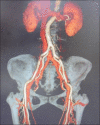Measures for Safe Laparoscopic Sacrocolpopexy: Preoperative Contrast-Enhanced Computed Tomography and Perioperative Ultrasonography
- PMID: 34040971
- PMCID: PMC8140534
- DOI: 10.4103/GMIT.GMIT_1_20
Measures for Safe Laparoscopic Sacrocolpopexy: Preoperative Contrast-Enhanced Computed Tomography and Perioperative Ultrasonography
Abstract
Laparoscopic sacrocolpopexy is one of the most difficult laparoscopic surgical techniques. In this study, we report on our efforts to safely perform this procedure, which consists of suturing a piece of mesh onto the anterior longitudinal ligament using a nonabsorbent suture during mesh fixation onto the prepromontorium layer, which can lead to massive bleeding if a mistake is made, by performing preoperative and intraoperative image evaluation. Preoperative contrast-enhanced computed tomography was performed. Images in DICOM format were acquired, and three-dimensional vessel reconstruction was performed. After performing a peritoneal incision in the presacral area, ultrasonography was performed using a probe inserted through a 12-mm trocar into the abdominal cavity to re-confirm the absence of vessels near the planned suturing area. After ultrasonography, an Ethibond® suture was inserted through the anterior longitudinal ligament. In our hospital, 126 patients underwent the procedure, and none had a serious hemorrhage or required blood transfusion, indicating the safety of this modified procedure without separation of a wide presacral area. We believe that these techniques can be performed safely with minimal incision. However, we did not examine the efficacy of these techniques in this paper. Further studies are needed to determine whether this approach is suitable.
Keywords: Computed tomography; laparoscopic sacrocolpopexy; ultrasonography.
Copyright: © 2021 Gynecology and Minimally Invasive Therapy.
Conflict of interest statement
There are no conflicts of interest.
Figures




Similar articles
-
Robotic Single-Site Sacrocolpopexy Using Barbed Suture Anchoring and Peritoneal Tunneling Technique: Tips and Tricks.J Minim Invasive Gynecol. 2017 Jan 1;24(1):12-13. doi: 10.1016/j.jmig.2016.06.012. Epub 2016 Jun 23. J Minim Invasive Gynecol. 2017. PMID: 27344033
-
Transvaginal Excision of an Eroded Sacrocolpopexy Mesh by Using Single-Incision Laparoscopic Surgery Equipment.J Minim Invasive Gynecol. 2017 Nov-Dec;24(7):1079-1080. doi: 10.1016/j.jmig.2017.04.001. Epub 2017 Apr 8. J Minim Invasive Gynecol. 2017. PMID: 28400220
-
Laparoscopic sacrocolpopexy: operative times and efficiency in a high-volume female pelvic medicine and laparoscopic surgery practice.Int Urogynecol J. 2017 Jun;28(6):887-892. doi: 10.1007/s00192-016-3179-1. Epub 2016 Oct 20. Int Urogynecol J. 2017. PMID: 27766346
-
The use of laparoscopic sacrocolpopexy in the management of pelvic organ prolapse.Curr Opin Obstet Gynecol. 2005 Aug;17(4):376-80. doi: 10.1097/01.gco.0000175355.48802.7b. Curr Opin Obstet Gynecol. 2005. PMID: 15976543 Review.
-
Abdominal approaches to pelvic prolapse repairs.Curr Opin Urol. 2013 Jul;23(4):306-11. doi: 10.1097/MOU.0b013e3283619e36. Curr Opin Urol. 2013. PMID: 23673511 Review.
Cited by
-
Prolapse Quality-of-life Questionnaire is a Reliable Postoperative Outcome Assessment.Gynecol Minim Invasive Ther. 2025 Jul 19;14(3):215-222. doi: 10.4103/gmit.gmit_74_24. eCollection 2025 Jul-Sep. Gynecol Minim Invasive Ther. 2025. PMID: 40786670 Free PMC article.
-
Various Laparoscopic Techniques in Pelvic Organ Prolapse Surgery.Gynecol Minim Invasive Ther. 2024 Jul 18;13(3):180-183. doi: 10.4103/gmit.gmit_113_23. eCollection 2024 Jul-Sep. Gynecol Minim Invasive Ther. 2024. PMID: 39184256 Free PMC article.
-
Improvement in Quality of Life after Laparoscopic or Robotic-assisted Sacrocolpopexy with a Single Anterior Mesh in Patients with Pelvic Organ Prolapse: A Retrospective Analysis from a Single Institution.Gynecol Minim Invasive Ther. 2024 Jul 18;13(3):168-173. doi: 10.4103/gmit.gmit_19_23. eCollection 2024 Jul-Sep. Gynecol Minim Invasive Ther. 2024. PMID: 39184259 Free PMC article.
References
-
- Ganatra AM, Rozet F, Sanchez-Salas R, Barret E, Galiano M, Cathelineau X, et al. The current status of laparoscopic sacrocolpopexy: A review. Eur Urol. 2009;55:1089–103. - PubMed
-
- Olsen AL, Smith VJ, Bergstrom JO, Colling JC, Clark AL. Epidemiology of surgically managed pelvic organ prolapse and urinary incontinence. Obstet Gynecol. 1997;89:501–6. - PubMed
-
- Nezhat CH, Nezhat F, Nezhat C. Laparoscopic sacral colpopexy for vaginal vault prolapse. Obstet Gynecol. 1994;84:885–8. - PubMed
-
- FDA Safety Communication: UPDATE on Serious Complications Associated with Transvaginal Placement of Surgical Mesh for Pelvic Organ Prolapse. 2011. [[Last accessed on 2019 Dec 30]]. Available from: http://wayback.archive-it.org/7993/20170722150848/https://www.fda.gov/Me... . - PubMed
LinkOut - more resources
Full Text Sources
